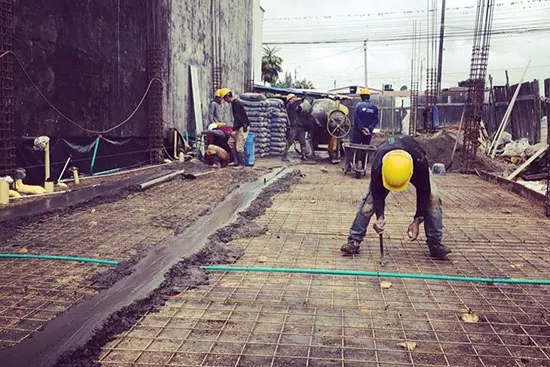Foundation slab calculation
Need a foundation slab calculation?
The foundation slab calculation is the process by which the necessary dimensions and characteristics are determined to design a concrete slab that will serve as the base or foundation of a structure, such as a building, house, or any other type of construction. This foundation slab is placed directly on the ground and its main function is to evenly distribute the weight of the structure, safely transmitting the loads to the ground.
It is a critical part of the structural design, as its proper planning ensures that the building remains stable, avoiding excessive settlements or irregularities in the foundation that could cause damage to the structure over time.

Key factors for foundation slab calculation
Soil analysis
Design loads
Dimension and thickness
Structural reinforcement
Importance of foundation slab calculation
- Ensures Structural Stability: The foundation slab is the base upon which the entire building is constructed. Accurate calculation ensures that the slab can properly support the weight and loads of the structure, preventing excessive settlements and guaranteeing the stability of the construction over time.
- Prevents Structural Damage: Inadequate calculation can lead to insufficient or over-dimensioned design of the slab. If the slab is not strong enough, it could develop cracks, fissures, or even collapse, jeopardizing the integrity of the structure and the safety of occupants.
- Optimizes Material Usage: Precise calculation allows sizing the foundation slab according to the loads and soil type, leading to efficient use of materials, avoiding waste, and reducing construction costs.
- Ensures Construction Durability: a well-calculated and designed foundation slab can withstand environmental conditions and anticipated loads during the building’s lifespan without premature deterioration.
- Compliance with Regulations and Standards: The calculation of the foundation slab must be done in compliance with the construction regulations and standards established by the competent authorities. This ensures that the structure is built in accordance with the safety and quality requirements set by current legislation.
- Reduces Financial Risks: Accurate calculation minimizes the likelihood of structural problems and future damage, avoiding costly repair or reinforcement work, as well as legal disputes.
- Approval of Projects by Competent Authorities: Construction projects must be submitted and approved by local authorities before commencing the work. Proper calculation is an essential requirement for obtaining the necessary permits to build.
Contact us
Basic information on data protection
Responsible: Cero Metros Cuadrados, S.L.
Purposes: Manage the sending of information that you request. Sending commercial communications.
Legitimation: Consent. You can withdraw consent at any time.
Recipients: Your data will not be transferred to third parties except in case of legal obligation.
Data subject's rights: To access, oppose, rectify and have their data deleted, as well as other rights as explained in the additional information.
You can access additional and extended information at this link.
FAQ
What is a foundation slab?
What types of foundation slabs are there?
- Floating Foundation Slab: It rests directly on the soil and extends across the entire area of the construction. It is ideal for soils with uniform load-bearing capacity and provides stable support for light structures.
- Mat or Raft Foundation Slab: Used in soils with low load-bearing capacity, this slab distributes the loads over a large area. It is common in multi-story buildings or heavy industrial structures.
- Pile-Supported Foundation Slab: In soils with low capacity, this slab is supported by piles that reach stable soil layers. It acts as a matrix, distributing the loads to the piles, and is useful in challenging geotechnical conditions.

